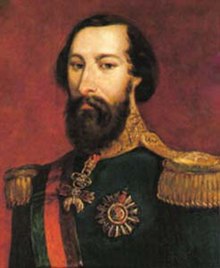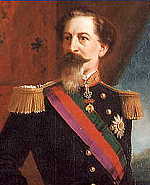Ferdinand II (Portugal)
Ferdinand II (born October 29, 1816 in Vienna , † December 15, 1885 in Lisbon ) was a prince of Saxe-Coburg and Gotha and king of Portugal , called the artist king ( o Rei-Artista ). The Coburg-Braganza dynasty he founded ruled the Kingdom of Portugal until 1910.
Life
Ferdinand, born as Ferdinand August Franz Anton, was the eldest son of Prince Ferdinand von Sachsen-Coburg-Saalfeld-Koháry (1785–1851) from his marriage to Antonie (1797–1862), daughter of Prince Ferenc József Koháry de Csábrág et Szitnya . His father had become a Catholic and a Hungarian citizen because of his marriage to the very wealthy Hungarian magnate. Like all Coburg princes, Ferdinand is said to have distinguished himself by his masculine beauty.
On April 9, 1836, Ferdinand married the widowed Maria II , Queen of Portugal, in Lisbon . The marriage by procuram took place in Vienna on January 1st of that year . On the occasion of the marriage, Ferdinand was elevated to Duke of Braganza with the title of Royal Highness . The marriage was arranged by Ferdinand's uncle, the Belgian King Leopold I. In the marriage contract, Ferdinand was given an annual maintenance fee of 9,000 pounds sterling, which would be doubled after the birth of an heir to the throne.
After the marriage, Ferdinand was appointed General Field Marshal by his wife , but under pressure from the Liberal Party had to immediately relinquish the post of army command . The rights of the royal couple were severely curtailed and Great Britain often intervened against the ultra-liberal party in the country. The government installed by Maria and Ferdinand was defeated in the elections of 1845, the royal couple suspended the constitution, and the Setembrists sparked civil war.
Through clever behavior, Ferdinand was able to transform the initial unpopularity, which was also due to his German ancestry, into the opposite. In the civil war years of 1846/47 Ferdinand was again given command of the army. After the birth of his eldest son, the Infante Dom Pedro de Alcantara (later Peter V ) in September 1837, he received the title of King ( Titular King ) as Ferdinand II in accordance with the Cortes of Lamego and the constitution of 1826 . November 1853 after the death of his wife, he was king-regent of the country for two years until the crown prince came of age, which came on September 17, 1855.
He rejected the Greek crown offered to him in 1862, as well as the Spanish royal title, which was offered to him in 1869 . The union with Spain under a single ruling house had aroused strong displeasure among the Portuguese population and was therefore vehemently rejected anyway.
The widower married for the second time on June 10, 1869. In Lisbon he married the opera singer Elise Friederike Hensler (1836–1929), who was raised to the rank of "Countess von Edla" . Apparently she, like his first wife, exerted a great influence on him. Since he was excluded from political life, Ferdinand devoted himself to painting and, as president of the royal academy, promoted the sciences and arts. He acquired the Palácio Nacional da Pena in Sintra and had it splendidly converted by Wilhelm Ludwig von Eschwege in the style of historicism . Here he lived with his second wife until his death. He was buried in the São Vicente de Fora monastery in Lisbon.
progeny
From the joint marriage with Queen Maria II of Portugal eleven children emerged:
- Peter V (1837–1861), King of Portugal
- ⚭ 1858 Princess Stephanie of Hohenzollern (1837-1859)
- Ludwig I (1838–1889), King of Portugal
- ⚭ 1862 Princess Maria Pia of Savoy (1847–1911)
- Maria (* / † 1840)
- Johann Maria (1842–1861), Duke of Beja
- Maria Anna (1843-1884)
- ⚭ 1859 the later King George I of Saxony (1832–1904)
- Antonia Maria (1845-1913)
- ⚭ 1861 Prince Leopold of Hohenzollern-Sigmaringen (1835–1905)
- Ferdinand (1846–1861)
- August Maria (1847–1889), Duke of Coimbra
- Leopold (* / † 1849)
- Maria da Glória (* / † 1851)
- Eugene (* / † 1853)
literature
- Helga Schedl: Ferdinand II. In: New German Biography (NDB). Volume 5, Duncker & Humblot, Berlin 1961, ISBN 3-428-00186-9 , p. 94 ( digitized version ).
Web links
- Karsten Poppe: Dom Fernando II. In Sintra - biographical data (notes from Sintra), November 4, 2008.
- Ralph Braun: Twenty Years of International Coburg Johann Strauss Encounters , Coburg 2007, p. 17 ( PDF )
- Harald Fidler: Königlicher Wahnwitz , in: Der Standard , February 23, 2006.
Individual evidence
- ↑ Neue Chronik der Weltgeschichte , Wissenmedia Verlag, 2007, p. 350.
- ↑ Wolfgang Menzel: History of the Germans up to the newest days , Cotta 1843, p. 1225.
- ↑ Oldenburg State Calendar , Schulze 1843, p. 38.
- ↑ Yearbook for European History 2007 , Volume 8, Oldenbourg Wissenschaftsverlag, 2007, p. 112.
- ^ EJ Feuchtwanger: Albert and Victoria: the rise and fall of the house of Saxe-Coburg-Gotha , Continuum International Publishing Group, 2006, p. 71.
- ^ Friedrich Wilhelm Schubert: The constitutional documents and basic laws of the states of Europe , Volume 2, A. Samter, 1850, p. 171.
- ^ Journal for the entire political science, Verlag der H. Laupp'schen Buchhandlung, 1854, p. 302.
- ^ HV Livermore: A new history of Portugal , Cambridge University Press, 1976, p. 295
- ↑ Rosemarie Arnold: Portugal , Baedeker, 2006, p. 76
- ↑ http://www.royaltyguide.nl/families/wettin/saxecoburggotha2.htm ( page no longer available , search in web archives ) Info: The link was automatically marked as defective. Please check the link according to the instructions and then remove this notice.
| predecessor | Office | successor |
|---|---|---|
| Mary II |
King of Portugal 1837-1853 |
Peter V. |
| personal data | |
|---|---|
| SURNAME | Ferdinand II. |
| ALTERNATIVE NAMES | Ferdinand August Franz Anton of Saxe-Coburg and Gotha; Ferdinand of Saxe-Coburg-Gotha-Kohary |
| BRIEF DESCRIPTION | King of Portugal |
| DATE OF BIRTH | October 29, 1816 |
| PLACE OF BIRTH | Vienna |
| DATE OF DEATH | December 15, 1885 |
| Place of death | Lisbon |


